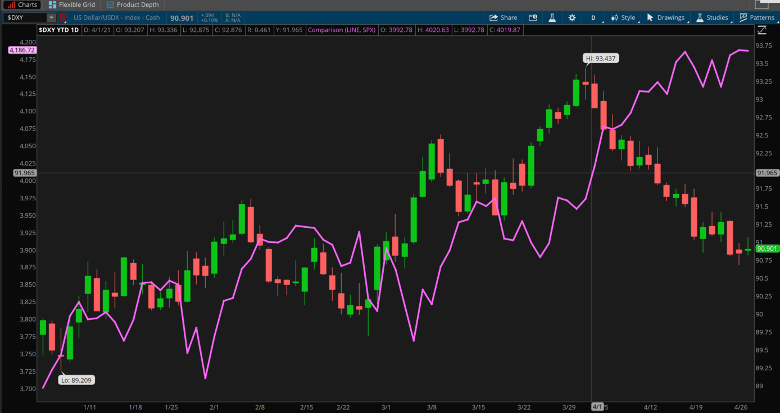If earnings season has a crescendo, we’re right in the middle of it.
Even as investors digest results from Alphabet (NASDAQ: GOOGL) and Microsoft (NASDAQ: MSFT), they await Apple (NASDAQ: AAPL) and Facebook (NASDAQ: FB) this afternoon. Along the way there’s a Fed meeting conclusion. Tomorrow morning brings gross domestic product (GDP) data, with Amazon (NASDAQ: AMZN) in the wings later Thursday. That’s a lot of trillion-dollar companies to juggle.
Early on, it will be interesting to see if the big Tech names that make up a large chunk of the market move in one direction and pull the broader market with them, or if they offset each other. If it’s the second scenario, the broader indices might not have much direction, considering the power these mega-caps have to pull things one way or the other. If there’s a tug-of-war, the big indices might not move much.
After settling in, there could be a lull in trading until we get to the Fed meeting conclusion at 2 p.m. ET, followed by Fed Chairman Jerome Powell’s press conference.
Big-Tech Tug-Of-War In Early Going
GOOGL and MSFT headed different pre-market directions despite both posting better than expected earnings. As we’ve seen a lot lately, a positive earnings surprise doesn’t always convert into rallying shares, mainly because so many stocks (MSFT and GOOGL among them) have already come so far.
Early media reports on MSFT’s Azure cloud platform performance in the company’s fiscal quarter might have led to some of the softness in shares. If you read the headlines, you might have thought Azure sales were “flat.” They were anything but, rising 50%, which was above the 46% analysts had projected. However, that was “flat” with the 50% growth Azure got the prior quarter, so there’s where maybe some confusion comes in. It’s hard to nitpick 50% growth for any product.
The horse race between Azure and Amazon Web Services (NASDAQ: AMZN) will get more visibility tomorrow afternoon when AMZN reports. That’s when we’ll see if MSFT picked up any more market share vs. its bigger competitor in the Cloud space.
GOOGL’s quarter got a nice boost from better than expected YouTube ad sales, and the company beat analysts’ estimates on top- and bottom-lines. However, traffic acquisition costs–an important metric–rose slightly. Cloud revenue was a little below expectations, which could disappoint investors hoping GOOGL can make a “dark horse” run against the thoroughbreds already far ahead on the track.
One interesting note: FB shares cruised to 2% gains in pre-market trading, possibly reflecting the strength in GOOGL’s advertising results. Everyone was uncertain what the ad environment would look like, and the assumption was that if GOOGL had solid growth, FB might, too. We’ll get the final word from FB itself on that aspect of business this afternoon.
Fed Takes Backseat To Earnings
It’s hard to remember the last time a Fed meeting was the third-most important thing going on in a week. Arguably, earnings and tomorrow’s gross domestic product (GDP) data are first and second, with the Fed a few games back in the standings.
All this doesn’t mean you shouldn’t pay attention to Fed Chairman Jerome Powell’s press conference after the meeting ends this afternoon. It just means many market participants don’t expect to hear much of anything new. We’ll talk a bit more below about what to expect when Powell takes the podium.
Instead, eyes could be on today’s earnings from Apple (AAPL) and Facebook (FB), and Thursday morning’s GDP and weekly initial jobless claims data. Don’t forget Thursday afternoon’s report from Amazon (AMZN), either. It’s definitely a full, rich week, and the last one before a new calendar month that could bring more focus on earnings and potential inflation.
Apple, Facebook, And GDP: A Full Calendar
AAPL has a tough act to follow after it enjoyed its first $100 billion revenue quarter last time out. In its fiscal Q1, it surpassed analysts’ estimates in almost every key category, whether it was iPhone sales, services, iPads, Macs, or wearables. Greater China sales rose 57%. Can AAPL hit it out of the park again? That’s what investors are wondering.
Going into AAPL earnings, consider keeping an eye on Services revenues–the category that includes cloud storage and backup, digital content and payment services. It’s grown so quickly that it’s elbowed its way up to the No. 2 business category spot for the company. The question is whether Services can keep up the strong traction it’s developed over the last few quarters.
Mac and iPad sales, too, might be a couple to keep tabs on, as many analysts have pointed out how the pandemic seemed to infuse new life into the lowly personal computer. AAPL’s rollout of new products last week could be a harbinger of what’s ahead.
The good times are also expected to keep rolling for FB. Its advertising prices were up 30% over 2020 levels as of mid-March, according to research from marketing agency Aisle Rocket. In the beginning of April, FB shares hit a new high of $315. In February, its monthly active user base reached 2.8 billion, which includes Instagram, WhatsApp, and Messenger.
As investors digest the latest from Powell, Apple CEO Tim Cook, and Facebook CEO Mark Zuckerberg, the government will post its first estimate tomorrow morning for Q1 GDP. Consensus on Wall Street right now is for 6.5%, according to research firm Briefing.com. If GDP comes in at, say, between 6.5% and 7.5%, the market isn’t likely to have too big a reaction. That’s kind of the expected range. Above that and maybe there’s a positive vibe on the Street, though it could also get Treasury yields climbing again.
The unlikeliest possibility seems to be something under the consensus. That’s because earnings and recent data all point toward impressive economic strength. Analysts have actually been raising their GDP expectations over the last few weeks thanks to all the positive numbers coming in.
To Taper Or Not To Taper: Fed Ahead
Getting back to the Fed, barring some kind of big surprise (and remember, the Fed has said it will give plenty of warning before changing any of its dovish settings), we’re likely to hear more of the same stuff from Powell and company. They’re probably going to acknowledge the recent positive jobs, housing, and retail sales data, but also reiterate that the economy is a long way from returning to pre-Covid health.
Minutes from the March Fed meeting, you might recall, explained that the Fed would only change the current policy once outcomes in the economy are actually achieved, not just because they’re projected to be achieved. They also said the $120 billion a month in Fed bond buying continues to support the economy. The minutes showed the Fed not worried about inflation, though it was discussed often at that meeting.
Also at the March meeting, the Federal Open Market Committee (FOMC) raised its outlook for economic growth and inflation. Its median 2021 GDP outlook went to 6.5%, with unemployment falling to 4.5% by year-end and inflation at 2.2%, which would be slightly above the Fed’s 2% target.
In an interesting development that may have implications for the 10-year Treasury yield, the 10-year breakeven inflation rate, as tracked by the Federal Reserve of St. Louis, recently rose above levels from late March when the 10-year yield hit its 2021 high of 1.78%. The breakeven rate has now crossed above 2.38%, the highest this year and an indication that maybe investors are taking the Fed’s word that the Fed won’t pump the brakes via policy anytime soon. So it may be no coincidence that the 10-year yield crossed back above 1.62% early Wednesday.
So the question going into today’s press conference is whether Powell indicates that the recent earnings and data have the Fed starting to think at all about tapering at some point. If he does, maybe it’s more of a market-moving event. Any hint of tapering probably would give the dollar a boost. It’s been rising a bit ahead of the meeting after falling from 2021 highs, so maybe some short-covering is happening here.
We’ll be back after the Fed meeting with more analysis of the decision and Powell’s press conference, so stay tuned.
CHART OF THE DAY: DOLLAR SELLOFF PAUSES. After falling like a rock for weeks, the U.S. dollar index ($DXY–candlestick) got a lift Tuesday ahead of the Fed meeting. This may be a sign of some investors covering shorts in case the Fed hints at getting more hawkish. The $DXY hit nearly two-month lows earlier this week and has gone opposite the S&P 500 Index (SPX–purple line) recently. Sometimes a weaker dollar can help companies with big markets overseas, making their products more affordable. Data Sources: S&P Dow Jones Indices, ICE. Chart source: The thinkorswim(R) platform. For illustrative purposes only. Past performance does not guarantee future results.
Revenue Eyed Over EPS: In general, earnings continue to look solid, but there’s a bit of a bifurcation developing between earnings and revenue. Take Monday morning, for instance. All 12 major companies reporting in that timeframe beat analysts’ consensus on earnings per share, according to data from Briefing.com. However, three of those came up short on revenue. More companies missed expectations on revenue than on earnings last Friday, too.
Remember, the bottom-line number isn’t really a very organic read on a company’s quarter, considering all the ways this can be massaged by the reporting firm or be knocked around from quarter to quarter by one-time events. There’s no hiding if a company’s revenue growth isn’t there, and that’s why you might see companies that miss on the top line get punished.
The Cost of Doing Business: In their earnings calls this week, three more companies–JetBlue (NASDAQ: JBLU), Procter & Gamble (NYSE: PG), and 3M (NYSE: MMM)–brought up the rising costs they face. For JBLU, the price of jet fuel has been spiraling higher, while PG and 3M see the cost of many materials they use in their products going up. During an interview on CNBC yesterday, 3M’s CEO Mike Roman went into a bit of detail about what they’re seeing and the impact going forward. What he called a “snapback in demand” after the worst of the Covid lockdowns has had an impact on the company’s supply chain. Logistics and raw materials costs are going up, “and we’re seeing that impact our business and impact our view going forward,” Roman said. “We expect to be able to manage inflation with price and our actions on supply chain improvements,” and the company is maintaining its earnings per share guidance for the year, he added. Still, the higher costs pose “a bit of a headwind” in Q2.
Other companies reporting before 3M also talked about raising prices related to the cost of raw materials and supply chain tangles, so now this looks like a trend. It wouldn’t be surprising at all to hear Fed Chairman Jerome Powell get asked about this in his press conference later today, but he’s been saying to expect transient inflation as the economy “snaps back,” to use CEO Roman’s words. Maybe this is evidence.
The Descending Dollar: Speaking of costs, it’s interesting to see the dollar bounce back a bit yesterday after its long descent (see chart above). The weak dollar recently has coincided–not surprisingly–with a dovish Fed and rising commodity prices. It’s also accompanied a significant upswing in the broader stock market. That’s not surprising, either, when you consider how a softer dollar can help many multinational companies doing business overseas. The soft dollar can make their products more affordable for non-U.S. customers. We’re at a point where the dollar index is getting near key psychological support around 90. It recently hit a nearly two-month low, but got a little bounce yesterday that might have reflected short-covering ahead of the Fed meeting.
TD Ameritrade(R) commentary for educational purposes only. Member SIPC.
Image Sourced from Pixabay
(C) 2021 Benzinga.com. Benzinga does not provide investment advice. All rights reserved.





